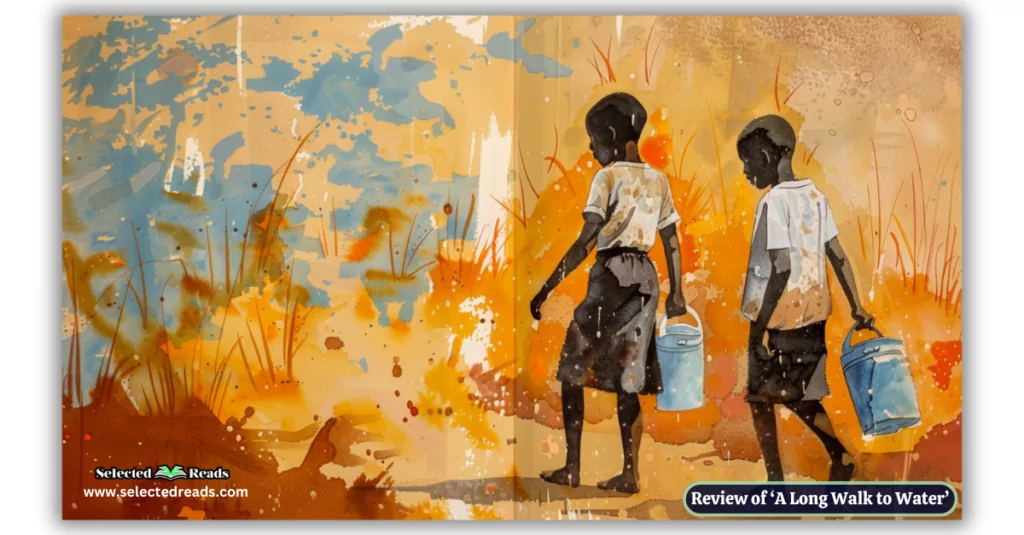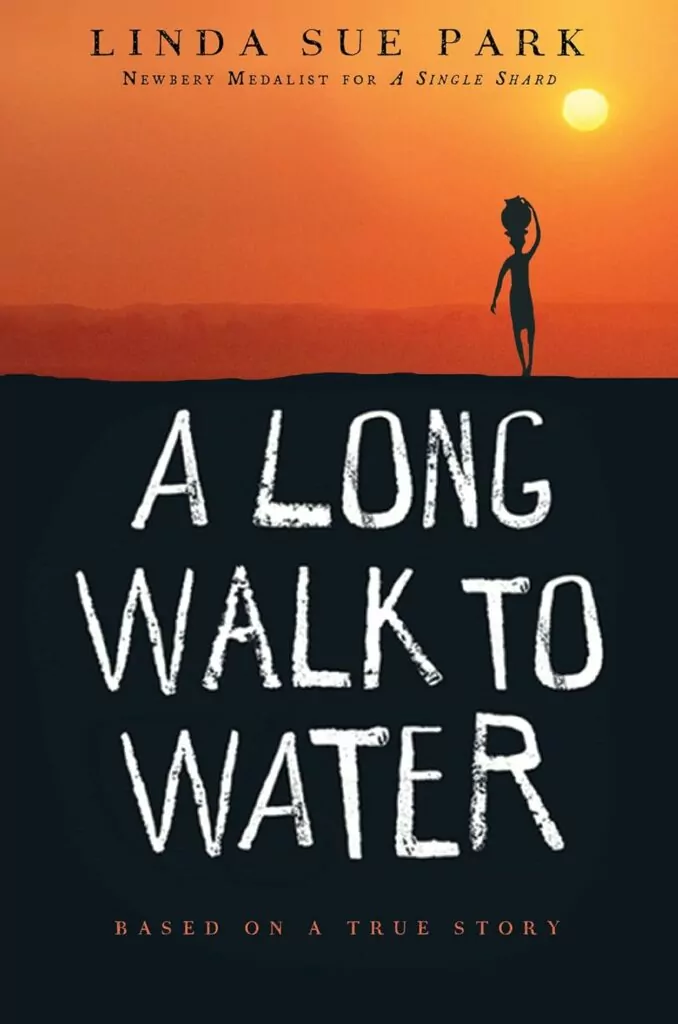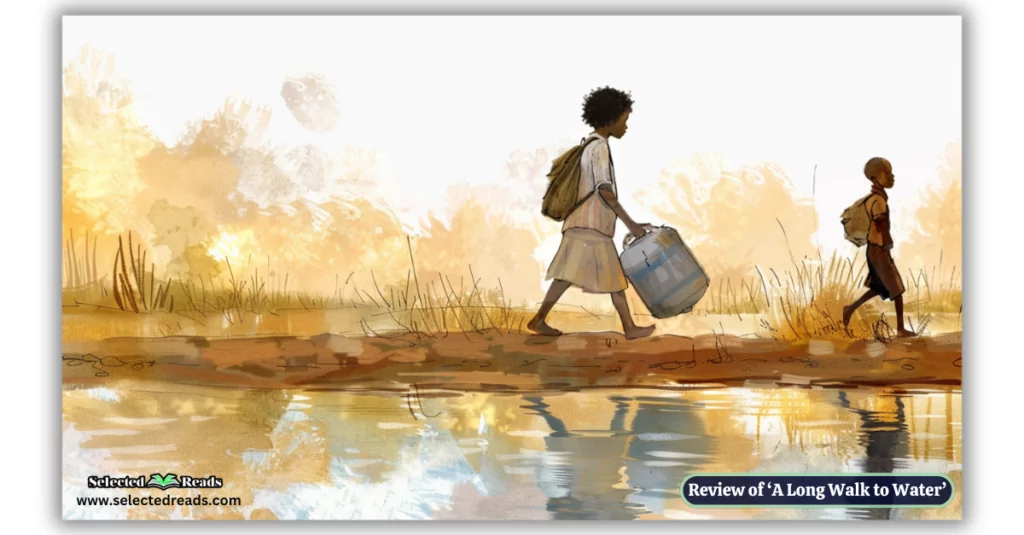Today, we delve into “A Long Walk to Water” by Linda Sue Park, a compelling narrative set in the challenging terrains of Sudan. This novel, categorized under children’s historical fiction, intertwines the stories of two young protagonists from different decades, offering a vivid glimpse into the harsh realities faced by those in war-torn Sudan.
The aim of this post is to introduce the novel’s key elements and thematic richness without giving away crucial plot details. We’ll begin with a concise summary of the story, followed by an analysis of the main characters. To enhance your engagement with the text, I’ll conclude with a series of thought-provoking questions designed for book club discussions.
A Long Walk to Water Summary
“A Long Walk to Water” by Linda Sue Park intertwines the narratives of two Sudanese children, Nya and Salva, who come from different times but share similar struggles. The novel alternates between these two characters, presenting their stories in parallel.
Nya’s story unfolds in 2008. She is an eleven-year-old girl who endures the daily challenge of fetching water for her family. Each day, Nya makes a grueling four-hour round trip—twice—to a pond that is two hours away from her village. The journey is arduous and the water she fetches is barely enough to sustain her family.
Salva’s story begins in 1985, during the outbreak of the Second Sudanese Civil War. Also eleven years old at the time, Salva is at school when his village is attacked by rebels. He is forced to flee, becoming one of the “lost boys” of Sudan—refugees who traveled across the African continent in search of safety and their families. His journey is fraught with dangers; he encounters armed rebels, predatory animals like lions and crocodiles, and faces the constant threat of dehydration and starvation. Despite these perils, Salva’s resolve remains unbroken.
Photo: Amazon
As Salva traverses Africa, he experiences profound loneliness and despair but also finds moments of camaraderie and kindness. His odyssey spans several years and takes him to refugee camps in Ethiopia and Kenya. Throughout his journey, Salva is driven by the hope of one day reuniting with his family.
The narratives of Salva and Nya converge in a poignant and surprising manner, illustrating the profound impact of individual resilience and efforts. Salva’s eventual success in leading a project to deliver clean water to South Sudanese villages, including Nya’s, ties their stories together. This project not only changes the lives of the villagers but also brings a sense of purpose and closure to Salva’s tumultuous journey.
The book concludes with an afterword by Linda Sue Park and Salva Dut, the real person on whom Salva’s character is based. Salva’s real-life accomplishments as the founder of Water for South Sudan are highlighted, providing a hopeful end to his and Nya’s stories of hardship and resilience.
Related: Synopsis of Trust (Novel)
A Long Walk to Water Characters
In “A Long Walk to Water” by Linda Sue Park, the primary characters are Salva Dut and Nya, whose stories provide a vivid contrast and connection through their individual struggles and triumphs.
Salva Dut: Salva is one of the main characters, whose story begins in 1985 during the outbreak of the Second Sudanese Civil War. He is an eleven-year-old boy when his life is disrupted by conflict, leading him to become one of the “lost boys” of Sudan. Salva’s character is marked by resilience, courage, and perseverance as he faces numerous challenges, including dangerous encounters with wildlife, the threat of armed rebels, and the harsh realities of life in refugee camps. His journey spans several years and multiple countries as he seeks safety and eventually works towards helping his homeland.
Nya: Nya’s narrative is set in 2008 and depicts the daily struggles of fetching water in a remote village in Sudan. At eleven years old, she makes a demanding four-hour round trip twice a day to a pond to collect water for her family. Her life is characterized by the physical and mental toll of her daily task, yet she is resilient and persistent. Nya’s story highlights the challenges faced by many in regions where access to clean water is a severe issue.
Secondary Characters:
- Nya’s Family: They are part of the background that illustrates the daily life and struggles of village residents dependent on distant water sources.
- Salva’s Family: His family is central to his motivation for survival and his hope to reunite with them throughout his ordeal. Their eventual fate impacts Salva deeply.
- Fellow Refugees and Friends: Various characters Salva meets among the refugees and in the camps play crucial roles in his survival and emotional journey. These characters help to build a sense of community and shared struggle.
A Long Walk to Water Book Club Questions
For your book club discussion on “A Long Walk to Water” by Linda Sue Park, here are some thought-provoking questions that can help delve deeper into the themes, characters, and narrative structure of the book:
- Contrasting Experiences: How do the alternating stories of Salva and Nya enhance the overall narrative? What do their journeys say about the universal struggles and resilience found in different generations?
- Character Development: Salva’s journey is one of immense personal growth and resilience. Discuss how Salva changes from the beginning to the end of the book. What are the key experiences that shape his character?
- Themes of Survival and Hope: Both main characters face severe hardships. Discuss the different ways in which hope is cultivated and manifested in their lives. How do these elements of hope influence their ability to cope with adversity?
- Cultural and Historical Context: What did you learn about Sudan’s history and the impact of its civil war through Salva’s story? How does the author use the characters’ personal stories to highlight broader social issues?
- Symbolism of Water: Water plays a central role in this story, symbolizing both hardship and salvation. Discuss the different ways water affects Nya and Salva’s lives. How does it represent broader themes in the book?
- Impact of the Setting: How does the physical setting influence the events and the characters’ actions in the book? Consider the challenges posed by the African landscape and the refugee camps.
- Role of Community and Family: How important are family and community in Salva’s and Nya’s lives? Discuss the different types of relationships presented in the book and their impact on the characters.
- Inspirational Real-Life Figure: Salva’s story is based on a true story. How does knowing this influence your reading of the book? Does it change your perception of the characters and events?
- Literary Style: How does Linda Sue Park’s use of simple language and short chapters affect the pacing and your engagement with the story? What impact does the straightforward storytelling have on the conveyance of the book’s themes?
- Call to Action: After reading about Salva’s efforts and his impact on his community, do you feel motivated or inspired to contribute to a cause? How effectively does the book engage readers in the real-world issues it describes?
Related: Lapvona Summary and Characters
Final thoughts
To conclude, I trust this brief exploration of “A Long Walk to Water” has piqued your interest. This novel, woven with themes of survival and resilience, offers a profound perspective on the human spirit’s capacity to overcome adversity. If you haven’t yet experienced this inspiring story, I highly recommend adding it to your reading list. Engaging, educational, and deeply moving, it’s a book that promises to resonate with readers of all ages, inviting reflection on the wider world and our place within it.









